A bit of a longer one today! I got writing this essay and couldn’t stop. Just one of those wild things we’ve got to let have its way with us sometimes…
If you’re new here - hi! And thank you for being here. The monthly newsletters are an amalgamation of musings, a poetry offering and announcements for all my upcoming events. These are free for all subscribers of Under a Fig Tree and come with an audio recording.
To receive my weekly (sometimes bi-weekly) Sunday posts with an audio recording, you can upgrade your subscription below. Thank you again if you are paying for this publication! Your contributions make it all possible.
And if you are unable to afford a full subscription, please send me an email on hello@gabrielagutierrez.net and I’ll send you a 20% discount for a year, no questions asked xox
There is a Secret One inside us; the planets in all the galaxies
pass through Her hands like beads.
— Kabir
There is an age-old question that sits at the centre of all the world’s great traditions. And it is this:
How can I live beyond the surface of myself?
In any life event that is triggering or confronting, be it an argument with a loved one, receiving news that destabilises us, or being faced with uncertainty, we have two choices: we can open ourselves to the discord, or shut down. In other words, we can keep our hearts open, or put up all the barriers and defences that keep us, ultimately, separate from the heart pulse of the world soul.
In the face of such challenges, opening can feel impossible. And we can have little if any negotiating power with the shut-down response.
This is fine. Sometimes tucking ourselves away in our inner cave is just the right thing to be able to locate our truth and orient ourselves towards it.
But if we stay shut down for too long, the myths and fairytales all tell us that there is an untamed wild in us, and, if we keep it locked away, it will cut out our heart.
One of my mentors Martin Shaw calls this force our Wild Twin. As far as I’m aware, he was the first to coin the term. Martin suggests that we were all born with a Wild Twin who was exiled at our birth. Our Wild Twin calls to us from the edges of the forest. It is the voice that beckons us to venture beyond our conventional, controlled self and to engage with something deeper and more chaotic. This is a journey that involves exploration, discomfort and embracing the unknown.
Martin uses the term to symbolise the parts of ourselves that are often suppressed or ignored in modern life - the parts that live just beyond civilisation, order and social norms; and he encourages a personal reconnection with the untamed, primal aspects of ourselves through myth, storytelling and a deep engagement with the wild or natural world. Here he is reading a section from his book ‘Courting the Wild Twin.’
Martin’s work centres on the idea that embracing the Wild Twin within us can lead to personal transformation, healing and a deeper connection to nature and the unconscious.
Courting the untamed and primal aspects of human nature is essential for any type of psychological and spiritual wholeness.
Fundamentally, the Wild Twin is the untamed, instinctual or shadow aspect of ourselves. It challenges societal norms and often serves as a guide, antagonist, or catalyst for transformation. It is a recurring concept in mythology, folklore and Jungian psychology.
In the stories, this figure is often depicted as a counterpart to a more civilised or socially accepted twin. In Roman myth, we have the twins Romulus and Remus who are abandoned on the banks of the River Tiber by their human parents and suckled by their adopted mother, the She-Wolf Lupa. Remus, who is often seen as the wilder of the two, is ultimately killed by Romulus, who goes on to found Rome (a civilisation).
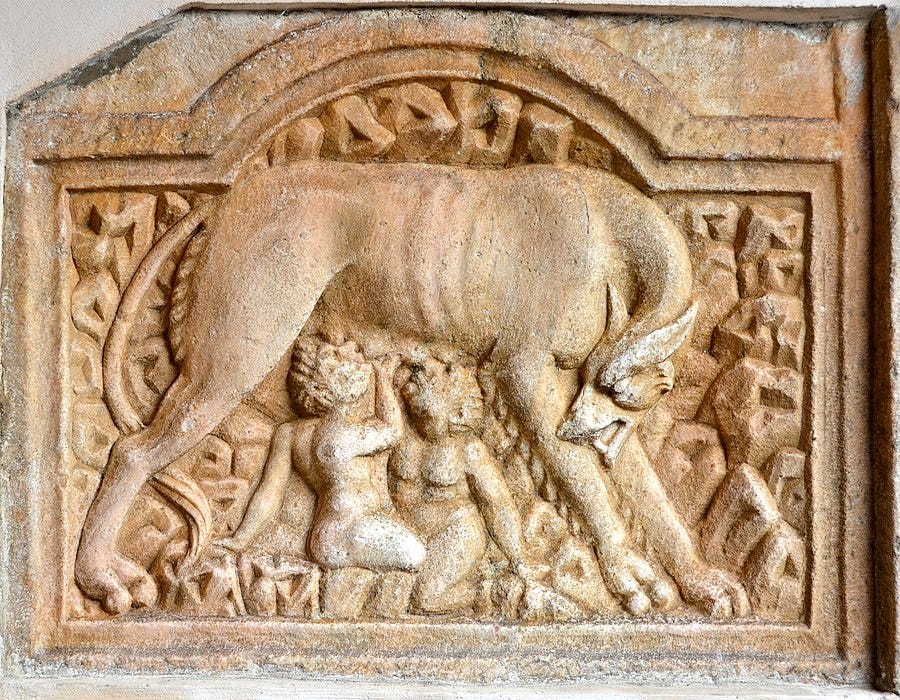
In the Mesopotamian myth of Gilgamesh, his lost brother Enkidu starts as a wild man living among animals before becoming Gilgamesh’s companion, symbolising the integration of primal instincts into civilisation.
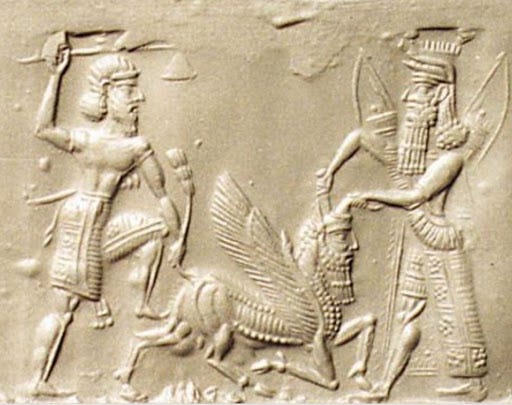
The Wild Twin can be understood as the embodiment of raw nature, chaos and sometimes even, danger. And as we’ve seen so far, they are frequently paired with a more refined, rational twin. This duality represents the tension between civilisation and nature, reason and instinct, or order and chaos.
In Jungian psychology, the Wild Twin can be interpreted as the “shadow self”—the part of the psyche that contains repressed desires, instincts and primal emotions. Encountering and integrating this shadow can lead to self-discovery and wholeness.
Jung’s language for this would be the “right path” and the “left path”. And Joseph Campbell continued the use of the term “left path” for what we could call an embrace of the Wild Twin.
Both Jung and Campbell’s work encouraged confronting the unconscious mind and societal conventions in order to move towards a fuller, more integrated self. For them, the left path referred to a journey that is often unconventional or counter to the traditional, socially accepted ways of life. It’s about breaking norms, exploring the unknown, and pursuing a type of wisdom that lies outside established structures. In their view, following the left path can lead to self-realisation and a deeper understanding of the universe, but it will inevitably involve risks, challenges and periods of isolation.
This identity struggle and pull between the two seemingly opposing forces within us was a grapple Frida Kahlo illustrated in her portrait The Two Fridas. Her painting reveals two versions of herself. One version is dressed in “civilised” European clothing, whereas the other wears a dress typical of Mexican peasantry. Her two selves hold hands while one of them - the one in so-called civilised attire - has her heart cut out.
Frida’s painting was inspired by the wondrously weird portrait of the two sisters by an unknown Renaissance artist that I’ve used as the cover image for this article.
The Wild Twin often exists on the fringes of society. They embody the liminal space between human and animal; culture and wilderness. They might be raised by animals, live in exile, or be abandoned at birth, reinforcing their liminal nature and outsider status.
Often, the Wild Twin’s fate is tragic. And their death or transformation serves as a necessary step for the “civilised” twin’s journey towards wholeness. It’s almost as though through the death of their twin, they get back their missing essence and become whole. The Wild Twin’s sacrifice often marks the other twin’s transition from a primal state to a more evolved or enlightened one.
The Wild Twin can also overlap with trickster figures or shapeshifters, as they challenge norms and bring about change through unpredictable actions.
In Biblical mythology, we have Jacob and Esau. Esau, the hunter, represents the Wild Twin, while Jacob, the cunning and favoured son, embodies civilisation.
While not strictly a “wild” twin, Castor and Pollus in Greek myth were the “light” and “dark” twins. Castor was mortal and Pollux divine, highlighting the contrast between human frailty and immortality.

The oldest Mayan myth tells of two hero twins Hunahpu and Xbalanque. They are creator deities and trickster characters responsible for the origin of the world. By facing trials that require them to embrace both their wild and strategic sides, they destroy the Underworld and instigate the creation of a new world.
The Wild Twin is a powerful symbol for the forces we struggle to reconcile within ourselves—instinct versus intellect, chaos versus order, and wilderness versus civilisation. In many stories, the key to balance is not the destruction of the Wild Twin, but understanding and integrating their energy.
In his The Birth of Tragedy, Nietzsche approaches Apollo and Dionysus as metaphors for these two fundamental artistic and existential forces. These figures, which he borrows from Greek myth, symbolise the opposing yet complimentary aspects of human experience.
In his study, Apollo represents order, logic, form, structure, containment and individual identity. He is the god of light, reason and harmony, and embodies clarity, beauty and measured control. Nietzsche associates him with the realm of dreams and artistic representation, where form and illusion provide comfort against the chaos of existence.
Dionysus, in contrast, is the principle of chaos, ecstasy, emotion, passion, instinct, intoxication and unity with nature. He represents the dissolution of boundaries, the surrender to primal forces, and the ecstatic loss of self in music and dance. Nietzsche connects him to intoxication, where individuality dissolves into a collective experience. Dionysian art is associated with music and the chorus in Greek tragedy, where emotions take precedence over rational form.
Nietzsche advocates for a balance between Apollonian structure and Dionysian intensity. However, with the rise of Socratic rationalism (represented by Euripides and later Western philosophy), this balance was lost and lead to an overemphasis on reason (Apollo) and the decline of the intuitive, primal self (Dionysus).
Nietzsche ultimately favours the Dionysian as the deeper, more life-affirming force. He saw it as a way of embracing suffering and the chaotic nature of existence without the need for illusory comforts.
The duality between the civilised and untamed counterparts of the self has been explored by various contemporary thinkers too. Helen Freeman, a London-based Jungian analyst and Principal Rabbi delivered a lecture titled “The Symbol of the Double” in which she examines the symbol of the twin in myth, legend and psychological development.
Why the Men Went Into the Woods: Jungian Psychology and the Archetype of the Wild Man is an article in which the Jungian psychotherapist Dennis Pottenger delves into the archetypal pattern of the Wild Man, discussing its significance in male psychological development and its representation in fairytales.
While Marie-Louise von Franz didn’t specifically use the term “Wild Twin” in her writings, she extensively explored the archetype of twins in myth and fairytales, and delved into themes of duality and the interplay between conscious and unconscious aspects of the psyche. In her work, she particularly examined the motif of twin creator deities and suggested that they embodied what she called a pre-conscious totality that encompassed all other archetypes.
Contrary to popular culture’s need to over-identify with one particular archetype - the wild woman, the mother, the whore, the wise man, the trickster - myths offer an opportunity to see all the players in us. Even the one who does the betraying, or the one who poisons the apple…
From this more holistic perspective, we might see our inner Twins as a representation of a unified source from which diverse archetypal energies can emerge.
This can help us understand the wrestle between these two seemingly-opposing sides of ourselves. Von Franz’s insights are a valuable perspective on the integration of these dual aspects within the journey towards psychological wholeness.
Like Jung’s concept of the shadow self, the Wild Twin represents parts of ourselves that are often disowned or ignored - our animalistic instincts, wild desires and chaotic potentials (to name but a few!). Instead of rejecting these elements, we can confront and embrace them as part of our path to growth. In this way, the Wild Twin can also be seen as a gateway to the integration of the shadow.
Honouring our Wild Twin can be a means of reconnecting the fragmented self. Our modern, overly-rationalised existence often leads to a disconnection from the natural world, our body, and our deep instinctual drives. Reclaiming the Wild Twin is a way of reclaiming wholeness - where both the civilised and wild aspects of the self must work together to create a full and dynamic existence.
Here are some prompts to journal on if you are hearing the forest call of the Wild Twin:
How can I embrace the chaos?
This is about reconciliation, reconciling the two opposing parts of ourselves, the paradox… What resources can you introduce into your life to regulate your nervous system and make more space for miracles and a middle way you may have never imagined?
How can I heal through nature and myth?
The Wild Twin has deep roots in ancient stories and folklore that reflect human relationships with animals, the wilderness and the unconscious mind. By embracing these elements, we can reconnect with the wisdom of the wild. Time in nature is one of the most profound ways to reconnect with these primal, untamed forces within us. The Wild Twin makes more sense in a forest. Through stories, rituals, and time spent outdoors - on a simple walk or camping or at a regular sit spot - we can begin to understand and integrate the Wild Twin within, not taming them, but honouring them.
Who is my Wild Twin?
Identify your deep yearnings, instincts, knowings, and unexpressed feelings and reflect on how you can give them a seat at the table of your life. If you could personify your Wild Twin, what would they look like?
How can I honour and integrate my Wild Twin?
Integrating the wild self isn’t about rejecting the “civilised” or ordered self, especially when it comes to our relationships. I think it can be an act of violence to constantly impose our inner worlds on each other. There has to be grace, too. And containment. And time for silliness and sweet nothings. The danger of the self-development world is to be constantly “in process”. There is a discipline and a deep love in knowing the difference between expressing our emotions and sending them to each other. I think keeping our emotions to ourselves sometimes, to let them transmute in the alchemical quiet - especially as women! - is a great act of love.
So this attempt isn’t so much about rejecting control and order, but about recognising the dynamic tension between structure and chaos. In a world that often prioritises structure and rationality, the Wild Twin is a necessary reminder for the creative and disruptive forces that bring change and growth. To engage with this wild aspect of the self is to acknowledge its power and allow it to lead us into new ways of being.
The modern-day mystic and Episcopal priest Cynthia Bourgeault teaches the importance of moving beyond superficial self-awareness in order to engage deeply with our inner being. She challenges us to transcend mere self-realisation and confront our deeper fears, like those of embodiment; or convergence and union with another. By doing so, we can reconcile the sacred and the secular, which may well in fact be a more integrated spiritual experience.
Bourgeault teaches on the automatic nature of emotional reactions, and that living solely on the surface keeps us confined to our reactive patterns. She contrasts this with what she calls a “deeper vest reservoir of feelingness” where emotions blend and transform, allowing for a richer and more nuanced experience of life. This depth can enable us to move beyond the reactive ego-self and access a more profound sense of presence and interconnectedness.
Her approach to integrating what we’re calling here the Wild Twin is to engage in contemplative practices and embrace the fullness of our emotional and spiritual depths. By doing so, we might well achieve a harmonious balance between our inner and outer worlds. This can ultimately lead us to a life of greater authenticity and spiritual fulfilment.
Wishing all these (wild!) things for you this month.
With love,
Gabriela
Poetry Offering
Not Taken, by David Whyte
Condensed and adapted from ‘Pilgrim: Poems by David Whyte’
The path you did not take,
ran with you for a while,
just the other side of the mountain,
or meandering with you on the far bank
of the onward river you followed;
the sound of its flowing water
holding your respective journeys together,
as if its merciful
but distant companionship
could always move with you;
always be with you,
waiting for you to cross over
as you always meant to,
when this path you had followed
had come to an end.
But you never turned to cross,
and you never found a bridge,
and you never took that other way,
and you stayed on this path to the end,
recalling the other way you did not take
as you would a close and loving friend
who had left you not to leave you but simply
to go on with their life, so that you carried
their memory through the years that passed…
growing with them as they grew,
walking with them as they walked,
until one day, it was just as if
that someone you had come to love
at a distance, and that someone
who had walked with you
always on the other side of the stream,
had passed away, but in your mind
you were still speaking to them
and still walking with them
and still carrying them onward,
…to the place where memory
and every day presence stop
living in separate worlds,
and the calm, death-still image
of every disappearance,
renews itself in some extraordinary
beginning again,
and you realize, sitting by their side,
saying goodbye,
that you took no separate path at all,
neither this nor that,
neither the one you loved
nor the one you did not want,
that you had after all,
always held them generously together
by not choosing this side of existence
or the other.
You were in the end,
never just looking on,
but always the river moving between
and the song of the water,
holding the flowing of ways together.
Announcements
MARCH 21 EQUINOX | Quarterly Oracular Guidance
This is a collaboration with my colleagues (and friends) Chelsy Arber and Emma Meadows in which we use shamanistic and esoteric techniques to divine answers to questions we are sent from around the world. Every Solstice and Equinox, you can send your questions in on anything from your relationships, health, business, life decisions, etc.
We are now taking questions for the Equinox.
MARCH 29 | Monthly Ritual
The first New Moon Dismemberment ceremony is coming up this month. Newcomers welcome! Please note there is an introductory video for you as a pre-requisite so you know the gist. Looking forward to seeing some of you there! As usual you can attend live or via recording.
Mentorship
I have opened up 3 more places for 1-1 mentorship. This is for anyone who would like support and/or supervision within both creative endeavours, spiritual work or personal support drawing on myth, stories, shamanic and animistic techniques for inner transformation.
These personalised sessions are structured to meet once a month for 3 months.
Upcoming Advice Column
I am currently gathering questions for my upcoming advice column The Ochre Papers. Thank you to those of you who have sent some in! The column will be free for a little while, and then put behind a paywall for paid subscribers. If you would like to send in a question, press the button below for all the details!




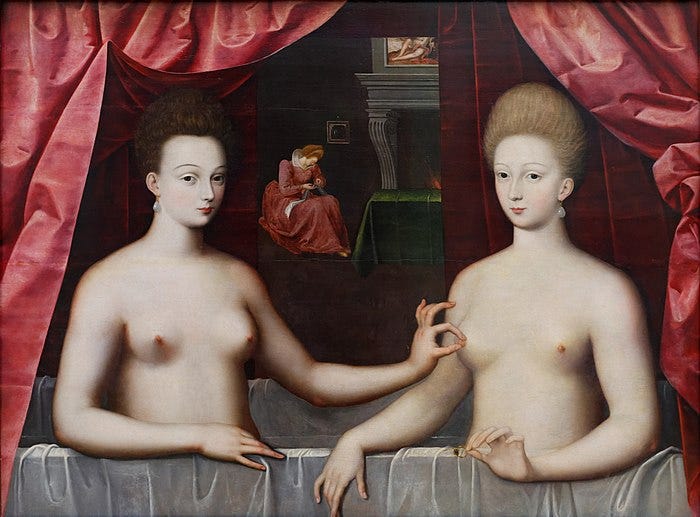

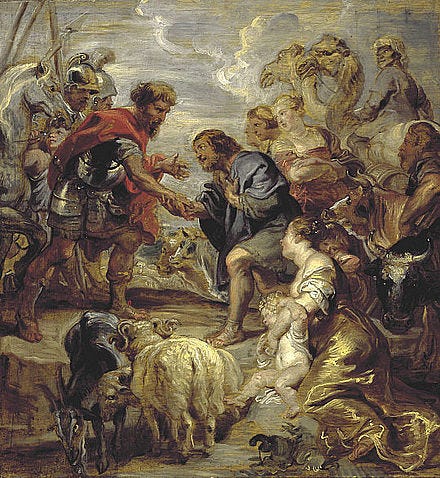
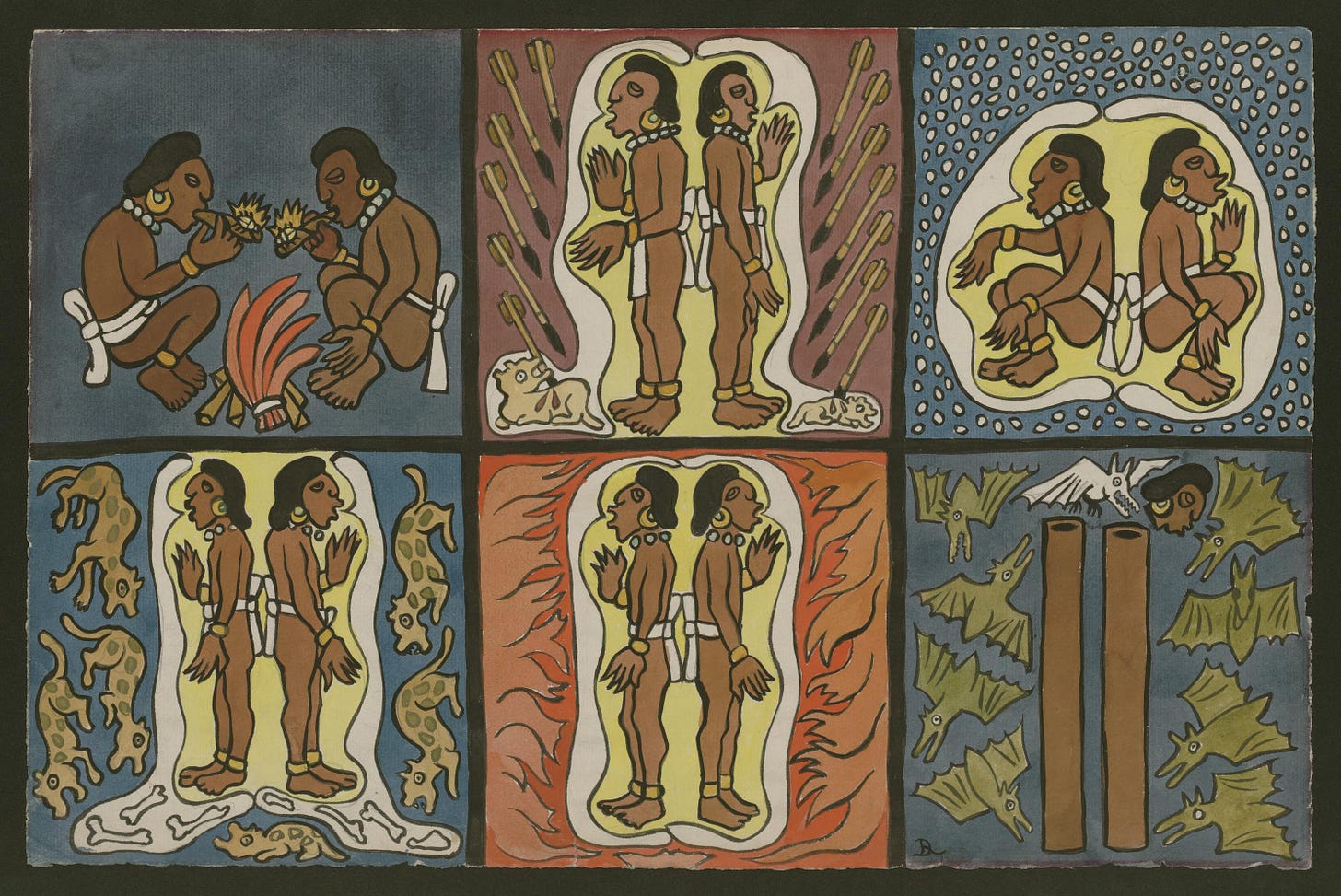
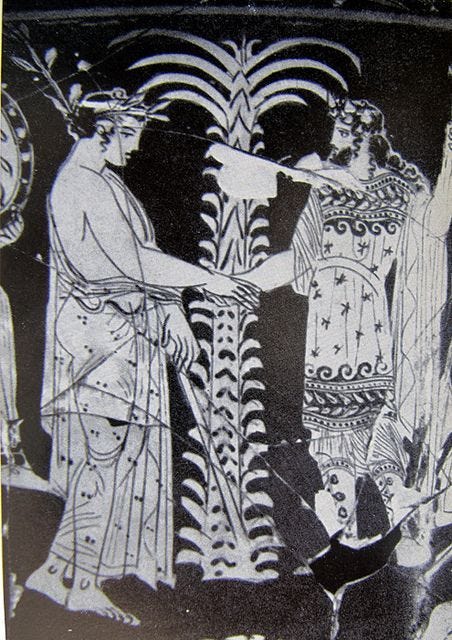
Oh... and is it a surprise that the wild takes over to tell its tale? Good you heeded the call and did not stop writing :-)
In Arabic lore, it's believed that to each human (inss: sensed/visible) there is a double in the jinn realm (invisible/imaginal) - they call this twin a Qareen (partner - rooted in qarn- as in horn of an animal.) The jinn is made from fire, the inss from earth. Jinn also Geni-genius - source of inspiration unbound by time and space- when honoured is a muse and alley in navigating the ghaib-the unknown - can lead to treasure; but when suppressed an entity that can cause illness/possession. The split you mention b/w Apollo and Dionysis might just be the cause of many ills in our world. May we continue to integrate our wild twin - dancing with her/him barefoot in the forest, across deserts, and (even) on man-made roads.
Thank you for your wonderfully full, life-affirming post today. In the company of grandchildren this week, we are dancing with one another’s Wild Twins.